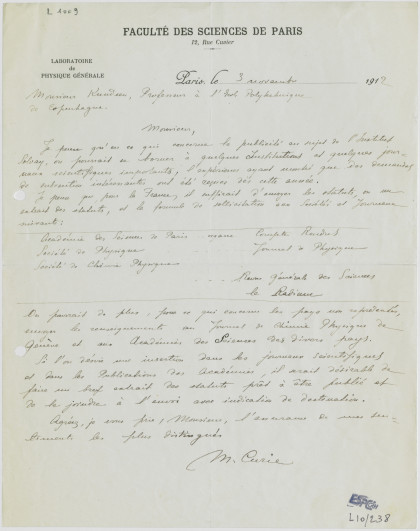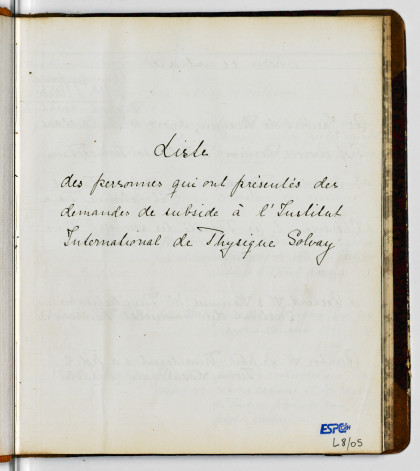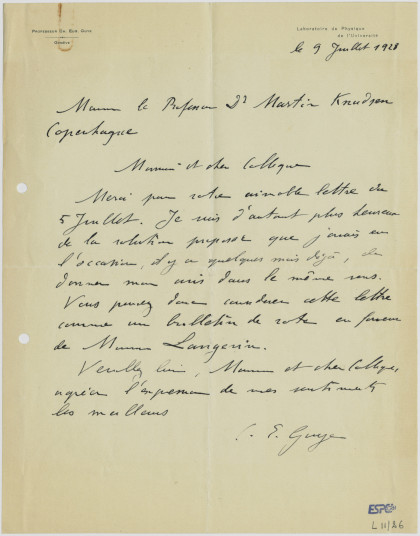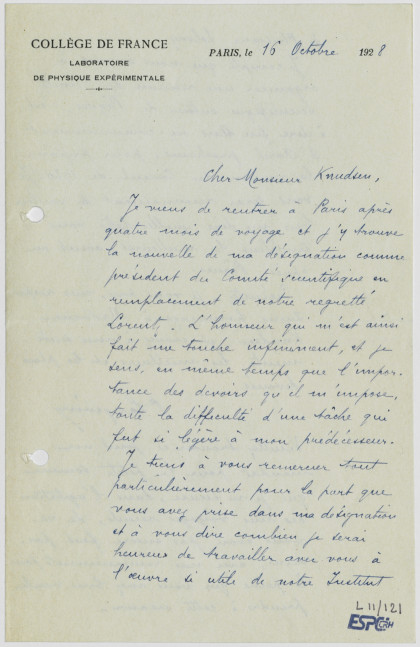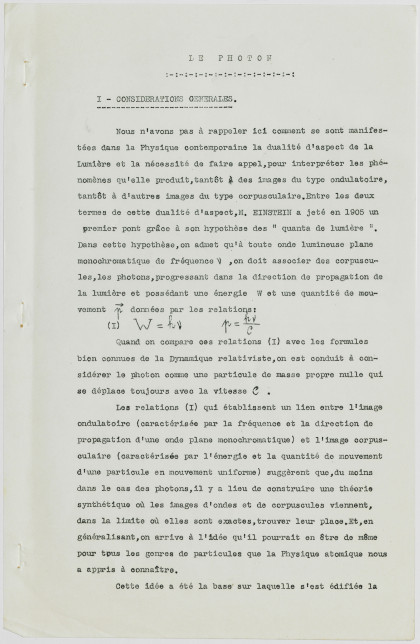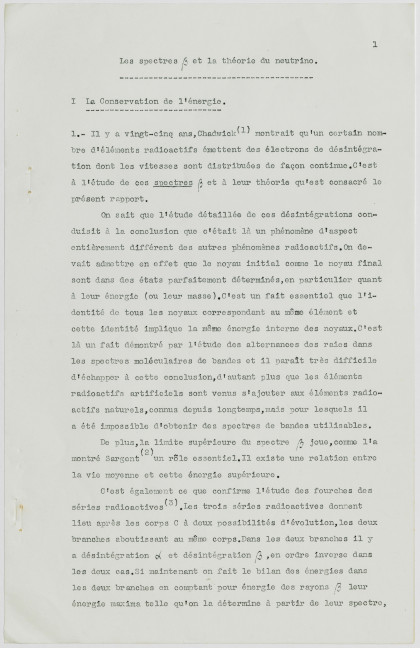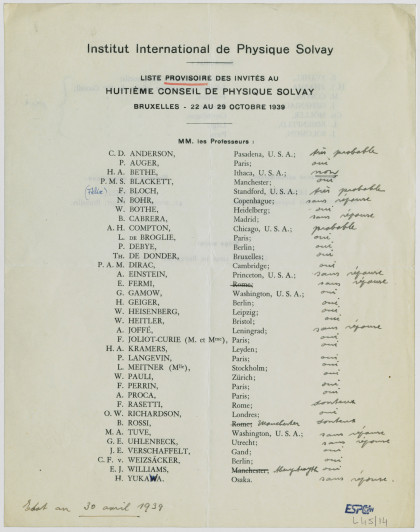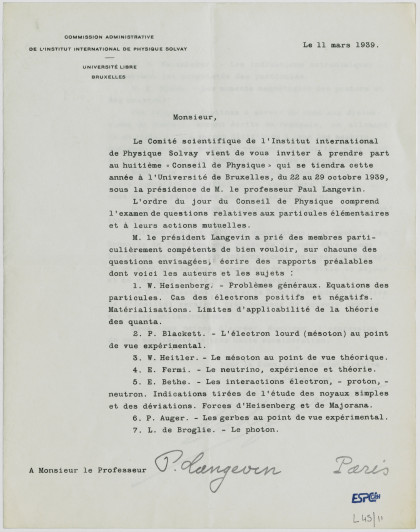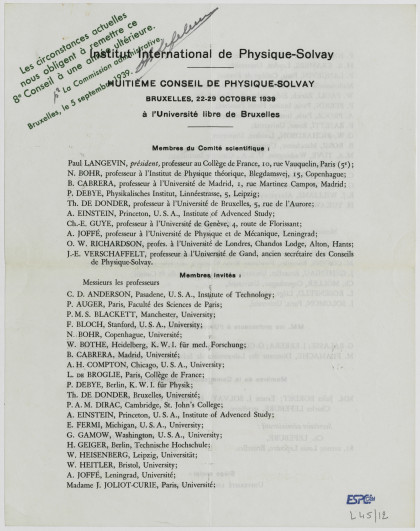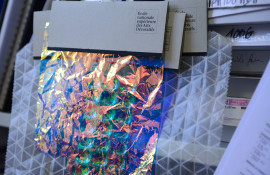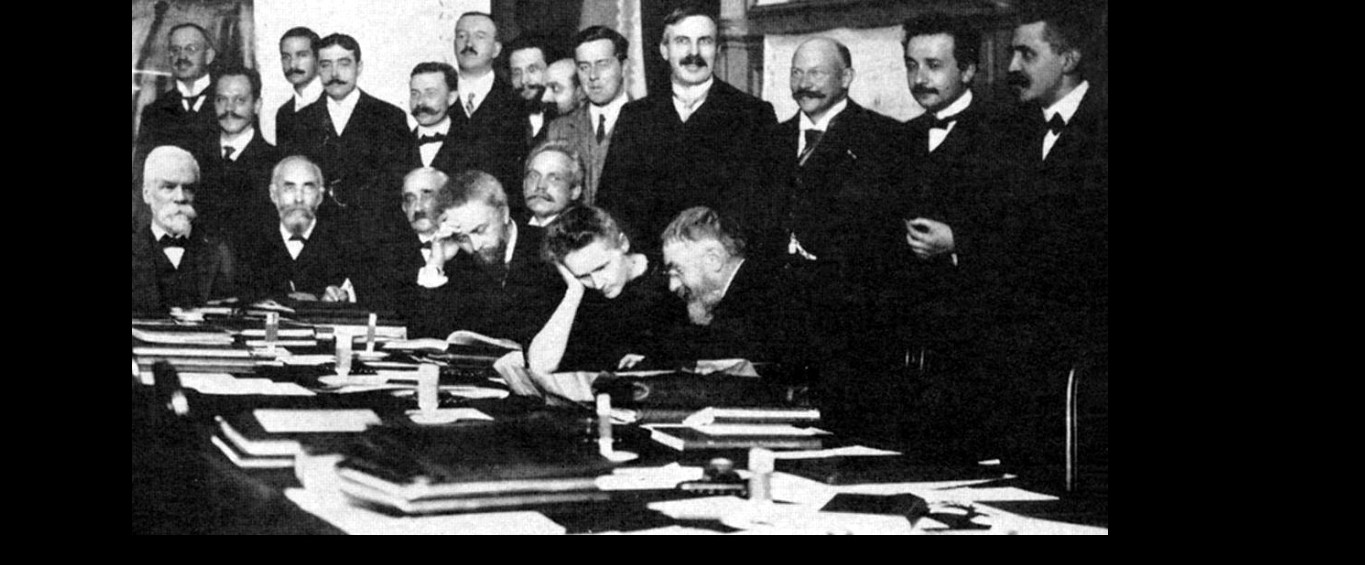
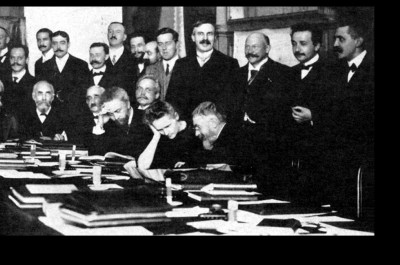
An Introduction to the Solvay Conferences on Physics
The early Solvay Conferences on Physics played a significant role in the evolution of Physics in the 20th century. They owe their existence to the generous patronage of the Belgian chemist Ernest Solvay, a lover of Science, who co-founded the Solvay Chemical company with his brother in 1863.
As the 19th century drew to a close, paradigm-changing scientific experiments on the physical properties of materials and on radiation radically upset the certainties of Classical Mechanics. In 1900, Max Planck introduced his black-body theory and along with it the idea of the quantum discontinuity of energy. Max Planck himself found the concept challenging and it clearly defied contemporaneous scientific understanding. In 1908, The Royal Swedish Academy of Sciences refused to award him the Noble Prize in Physics on the grounds that his theory was based on an "unacceptable hypothesis" – even though Einstein's work on the photoelectric effect, published in 1905, concurred. Walther Nernst, the German chemist and physicist, was the principal architect of the first Solvay Conference. Nernst, then Director of the Second Chemical Institute at the University of Berlin, contacted Ernest Solvay through the good offices of one of his ex-students, the Belgian Robert Goldschmidt, with a proposal to invite a select group of physicists from around the world to an international conference devoted to debating the new theories of physics and attempting to reconcile molecular-kinetic theory with Planck and Einstein's quantum approaches to energy and radiation. Nernst also saw the debate on quantum theory as an opportunity to confirm his Third Law of Thermodynamics, introduced in 1905.
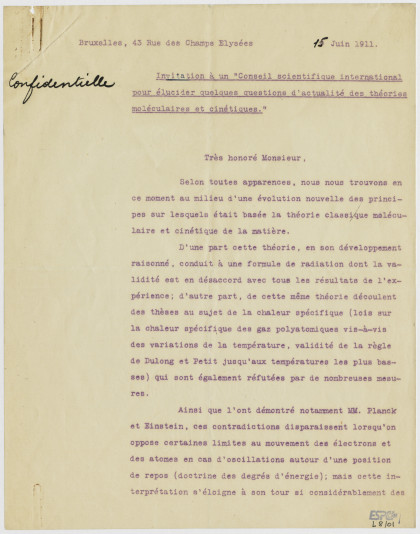
Ernest Solvay, chemist, industrialist and philanthropist was a lover of Science; by 1911 he had already founded the Solvay Institute of Sociology and the Solvay Business School at the Université Libre de Bruxelles. He enthusiastically accepted Nernst's proposal and convened the First Solvay Conference in Brussels in October 1911. The conference was attended by 18 of the world's leading physicists (German, French, British, Belgian, Dutch, Austrian and Danish) most of whom were already or would become Nobel Laureates, including Albert Einstein, Henri Poincaré, Paul Langevin, Hendrik Antoon Lorentz, Max Planck, Walther Nernst, Maurice de Broglie, Ernest Rutherford, Heike Kammerling Onnes, Marcel Brillouin, Jean Perrin, and one woman, Marie Curie.
Unlike the earlier international physics conventions organized in conjunction with the Paris Exposition Universelle of 1900 and the Saint Louis World's Fair in 1904, primarily to deliver reports on the successful solution of scientific questions, the Solvay Conferences were conceived as invitation-only symposia bringing together a limited number of recognized specialists to debate a specific theme defined by an international scientific committee in order to contribute to solving unusually difficult scientific problems. The first Conference in 1911 was chaired by Hendrik Lorentz who also served as a sophisticated and polyglot moderator during the Conference's often heated debates. In preparation for the Conference a dozen scientific papers by participants were sent ahead to all invitees.
The Solvay Conference of 1911 is considered a turning point for modern Physics: Poincaré returned from the conference convinced by the quantum theory of energy and Louis de Broglie was introduced to quantum theory for the first time, as his personal notes attest, setting the stage for his future groundbreaking contributions in the field.
During the debate sessions participants received typed copies of their colleagues' presentations in French, English and German.

From the 1911 Conference to the creation of the Institut International de Physique Solvay (IIPS)
Encouraged by the success of the first Conference, Robert Goldschmidt suggested to Ernest Solvay that they continue the adventure. In 1912, Solvay provided the funds required to establish and maintain the Institut International de Physique Solvay (IIPS) whose goal was to encourage research in experimental physics by providing scholarships and grants to young researchers. The IIPS, governed by an Administrative Council and an International Scientific Committee, was also responsible for organizing regular Solvay Conferences, based on the 1911 model. Thus, the 1911 Solvay Conference on Physics became the first in a long series that continues to this day.
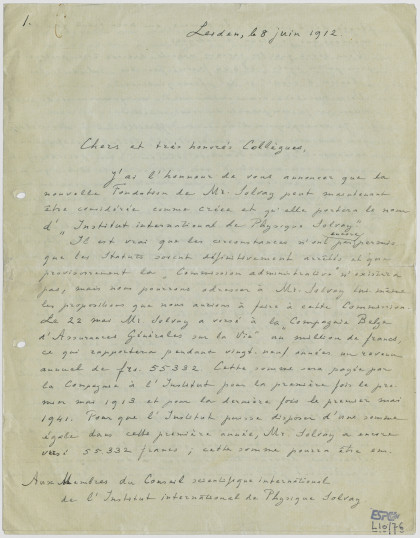
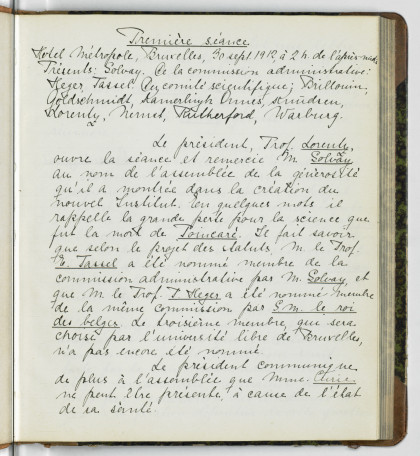
The second Solvay Physics Conference, devoted to The Structure of Matter, took place in 1913. It brought together close to 30 scientists from nine different countries. During the Conference, in a discussion following J.J. Thomson's report, Rutherford presented his atomic nucleus model. Marie Curie and Paul Langevin were the only participants to comment on his theory.
The First World War and its consequences
The outbreak of the war in the summer of 1914 obliged the Institut to suspend its activities. Lorentz and the International Scientific Committee were able to resume their work following demobilization in 1919; but the third Solvay Physics Conference took place only in 1921 after the liberation of Belgium. The reports from the 1913 Conference were also published the same year.
The third Solvay Physics Conference dedicated to "Atoms and Electrons" was held in April 1921, but the boycott of German intellectuals that followed the publication of the "Manifesto of the Ninety-Three" resulted in the exclusion of some of the Conference's most brilliant participants, despite Lorentz's attempts at appeasement. Einstein, an outspoken pacifist and internationalist, was an exception; although he did not attend the Conference, he contributed to the proceedings via a written contribution. Niels Bohr, the Danish physicist was also absent (due to illness) but a report covering the main points of his seminal 1913 paper on the structure of the atom was read to the Conference by Paul Ehrenfest. Albert Michelson (Nobel Prize 1907) and Robert Millikan (Nobel Prize 1923) attended for the first time. The third Solvay Conference on Physics marked a decisive step forward in our understanding of the structure of matter, in particular thanks to the work of Rutherford and Bohr.
The fourth Solvay Conference on Physics devoted to "Electrical Conductivity of Metals and Related Problems" was held in 1924, two years after Ernest Solvay's death. Participants hailed from 13 countries; Russia was represented for the first time, by Abraham Joffé. But Germany was still persona non grata. Although he was not considered German and therefore invited participate, Einstein refused to attend as long as his German colleagues were barred, stating, "it is not right for me to take part in the Solvay Congress because my German colleagues are excluded. In my opinion it is not right to bring politics into scientific matters, nor should individuals be held responsible for the government of the country to which they happen to belong." It is only in 1926, after Germany joined the League of Nations, that German scientists were once again welcome to participate in European intellectual circles.
International relations resume - Paul Langevin's Presidency
The fifth Solvay Conference on Physics, held in 1927, is one of the three most important conferences prior to WWII along with those of 1911 and 1933. The German scientists were once again welcome and Einstein had been appointed to the International Scientific Committee. The Committee was the scene of fierce controversy between prominent physicists, particularly between Bohr and Einstein, on questions of quantum mechanics and specifically on the Copenhagen Interpretation, opening the door to the future debate on determinism in quantum physics. The controversy carried forward to the 1930 Scientific Committee meeting, the first presided over by Langevin.
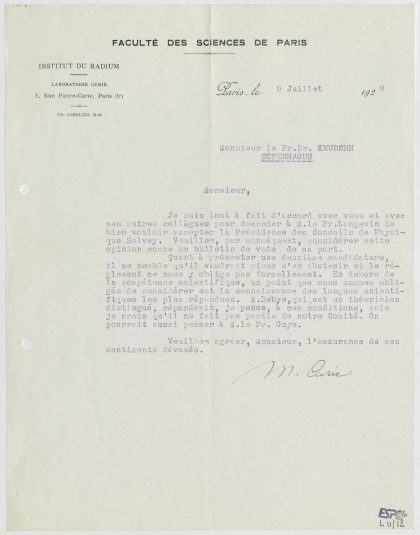
In his letter of acceptance, Langevin proposes a date for the next Committee meeting devoted to preparing the sixth Conference on Physics scheduled for 1930, the last for Einstein before his departure for the United States and the first to be hosted by the Université Libre de Brussels.
Langevin decided to devote the sixth Conference to "The structure and Property of the Atomic Nucleus", a subject that turned out to be a "hot" scientific topic of the moment – Chadwick, who attended the Conference, had only just discovered the Neutron (1932).
The 1932 Conference is among the most outstanding, with close to 40 participants equally divided between experimental and theoretical physicists (as Paul Langevin pointed out), including numerous young physicists.
Irène and Frédéric Joliot-Curie presented a discussion on the complex structure of the proton prefiguring their discovery of induced or man-made radioactivity; Wolfgang Pauli presented his postulate for the neutrino; Dirac presented a report on the positive electron, also known as the "positron", and Heisenberg discussed the Gamow's droplet model of the nucleus.
The 1933 Conference marked the dawn of a new era, the era of Nuclear Physics. It was also the longest Conference to date, lasting a full week.
World War Two – a turning point
The eighth Conference, on the theme "Cosmic Radiation and Atomic Physics", was initially planned for 1936 but was deferred due to the uncertainty caused by the rise of Nazism. Despite the turmoil, the conference was rescheduled for 1939 and devoted to "Elementary Particles and Interactions". Louis de Broglie was to present a report on the Photon (L46/03) and Jacques Salomon an additional report on the "Neutrino Theory of Light". Paul Langevin's son-in-law, Jacques Salomon was a promising young physicist and member of the French Resistance. He was executed by the Nazi's at Mont-Valérien in 1942. (L47/02)
By 1939, organizing a Conference had become a complex and demanding task. From an initial 23 members in 1911, attendance had reached closed to 50 by 1939 with participants from across Europe and beyond including 7 from the United States and one from Japan (L45/14). In accordance with the President's wishes, reports were to be written in three languages and handed out to participants several weeks prior to the Conference so that they could serve as a basis for discussions. (L45/11).
But the outbreak of World War II obliged Jacques Langevin to put off the eighth Conference once again (L45/12).
Langevin passed away in 1946 and the eighth Conference on Physics was finally held in 1948, under the Presidency of Frédéric Joliot.
Conclusion
In the 1950's, the rise of Big Science with its large-scale projects, big budgets, big staffs, big machines and big laboratories, transformed the way physicists relate to scientific discovery. They no longer work alone or in small teams but rather as members a big research teams working together in big laboratories. They also devote significant time to "bibliographic activities", i.e. they keep informed of scientific advances across the globe in their field almost in real time thanks to scientific journals, data bases, and electronic resources. Symposia, conferences, seminars, study sessions and other platforms where they can present their research and exchange are now part of their everyday life. Physicists are most often solicited to present work that has already been published. But at the same time, new forms of debate and critical analysis have emerged such as peer reviewing, moving the scientific debate "up-stream" prior to publication.
The first Solvay Conferences on Physics in many ways prefigured what we experience today: they were a unique forum, a physical space where a scientific elite could meet, exchange and debate on controversial scientific issues. It is not a mere coincidence that the Solvay model was born at a time when Science faced fundamental epistemological questions about the property of matter and the laws of physics.
This Focus was conceived and written by Catherine Kounelis, Director of Documentation and historic Resources, ESPCI and Lise Facchin, PSL digitization project manager.
Paul Langevin's archives relating to his chairmanship of the Solvay councils can be found in the PSL digital library.
To learn more …
« Les Conseils Solvay et la physique moderne », P. Marage et G. Walleborn, in Histoire des Sciences en Belgique, 1815-2000, Bruxelles, 2001
« Internationalisme scientifique et révolution quantique : les premiers Conseils Solvay », Franklin J. Lambert, in La fabrique internationale de la science. Les congrès scientifiques de 1865 à 1945, Revue germanique internationale, CNRS éditions, 2010
Walther Nernst and the Transition to Modern Physical Science, Diana Kormos Barkan, Cambridge University Press, 1999
Une entreprise au cœur de l'histoire. Solvay 1863-2013, Kenneth Bertrams, Cambridge University Press, 2013
"The Early Solvay Councils and the Advent of the Quantum Era", Francklin Lambert, Frits Berends and Michael Eckert in The European Physical Journal Special Topics, vol. 224, sept. 2015, pp. 2011- 2125.
You can also consult Salamandre, the Collège de France digital library and on-line archive catalogue and the site dedicated to the history of Solvay Institutes and Councils: The Solvay Science Project
